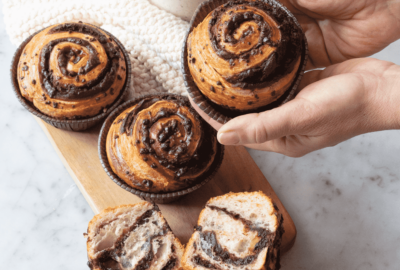Whether you are a hotel, care caterer, café or cost-sector caterer breakfast or brunch will most likely be an important part of your business – in fact it has become so significant, pubs and restaurants are expanding their menus in a bid to secure a share of a consumer market that is estimated to be worth over £7.3 billion.
From hot breakfast rolls to light bites, ramen noodles, sweet treats and boozy brunches, there has never been so much choice tempting us out of our homes every day of the week, providing opportunities to catch up with friends, find some quiet time to ourselves or simply fuel up to help us face the day ahead.
Out Of Home Trends
Prior to the recent pandemic, it was estimated that 35 million adults in the UK and 17% of consumers in Ireland ate breakfast out-of-home every year with the demand for breakfast and brunch being twice as strong amongst millennials than any other consumer group. While weekend trade has been a significant contributor to growth in this market (almost 50% of adults surveyed in the UK stated that they go out for breakfast as a weekend treat), a 15% rise in the number of people working more than 48 hours a week has driven weekday demand. Breakfast at home is often one of the most sacrificed meals when time is scarce and as such, 1 in 3 consumers who skip breakfast at home are opting for grab-and-go solutions as part of their daily commute.
The top four breakfast items have rarely changed over the years, with pastries topping the bill as firm favourites “Over the past five years our sales of fresh and frozen viennoiserie have increased by +30%” comments Stéphanie Brillouet, Marketing Director, Délifrance. However, this doesn’t mean to say that consumers are not willing to branch out. Global foods currently influencing dinner and lunchtime menus are now appearing on breakfast and brunch menus too, with dishes such as Shakshuka, Turkish poached eggs or Southern style biscuits and gravy becoming popular choices.
A Healthy Start To The Day
Still considered one of the most important meals of the day, it is not surprising that consumers are keen to have a healthy breakfast. Porridge remains one of the go-to options for operators in every sector due to its versatility. Whether topped with fruit, nuts or a touch of honey, it provides a fibre rich source of carbohydrates to fuel our bodies, support gut health and helps us feel fuller for longer.
Fruit pots and cereals in a bag are great grab-and-go options which meet the needs of a broad range of dietary requirements, but try branching out a little, adding bircher muesli with stewed fruit, protein bars or overnight oats to your menu. “Overnight oats are a fantastic breakfast option for those working across the cost-sector. Where calorie intake is an essential consideration – chefs can simply switch from Philadelphia Light to Philadelphia Original for residents to benefit from its excellent fortification properties” comments Gareth O’Hara, Philadelphia Professional Healthcare Chef Ambassador.
Adding vegan dishes to a breakfast or brunch menu is quick and easy, using vegan friendly yoghurt, oat, cashew, almond or coconut milk and for hot options, vegan sausages and beans or avocado on toast. However just because it is vegan, does not mean it is healthy as Luxey Dayanandan, Head of Wellness & Nutrition at RA Group notes; “Vegan options are usually considered to be healthier, but they can be high in fat, sugar and salt so carefully consider the ingredients you use and the overall nutritional profile of the recipe. Be mindful of the sugar content in items such as smoothies as it can often creep up when using fruit and juices which impact blood glucose levels.”
Indulgent Treats
Breakfast and brunch is not just about eating healthily, it is also seen as a luxurious treat. “As a society, we’re more health conscious than ever, but ‘good behaviour’ with eating and exercise often leaves people feeling like they deserve a treat. On the flip side, those less interested in leading a healthy lifestyle often use indulgent food as easy gratification. It just goes to show that there’s always going to be a place for more indulgent options, no matter who your customers are” says Bee Farrell, Culinary Anthropologist.
Adding a little sweetness to your menu by way of pancakes, waffles or pain au chocolat will give your business broader appeal “Once seen as exclusively an after-dinner treat, sweeter choices have become much more inclusive with consumers choosing more indulgent items across the whole day” comments Anna Sentance, Gourmet Marketing Manager, Callebaut UK and Ireland.
Although breakfast menus clearly feature some well loved favourites, when it comes to brunch, operators can throw the rule book out of the window and get creative with dishes that are more akin to lunch and attract a diverse population. Whichever route you choose, your level of success will be dependent upon the quality of your ingredients, breadth of selection and your ability to meet the needs of an increasingly demanding consumer.
Feeding Young Minds
With many schools operating breakfast clubs and universities featuring on-campus cafés, breakfast in the education sector is an important consideration. Quick and easy options of fruit, cereal and bagels are great staples, although keeping abreast of food trends will help encourage engagement amongst younger consumers. Category blurring for breakfast is one such trend that is worthwhile investigating, including dishes such as smoothie bowls, drinkable oats and popcorn muesli.
“Popcorn is a great way to add wholegrains into the diet” explains Luxey Dayanandan, Head of Wellness & Nutrition at RA Group, “experiment with flavours, perhaps a little cinnamon or paprika. Oatcakes with sliced tomatoes or some easy home bakes using dried fruit, oats, seeds and low fat spread to make flapjacks or berry balls can be a great way to get more fruit into children’s diets and will help provide valuable vitamins and minerals outside of main meals to fuel them through the afternoon.”
In the higher education sector, think about what influences purchasing decisions, introducing drinks such as kombucha which is currently popular amongst younger, health aware consumers or increasing the variety of vegan dishes on your menu. This sector is the most convenience oriented and will be price sensitive, so meal deals with grab-and-go options will be key to drive sales.


